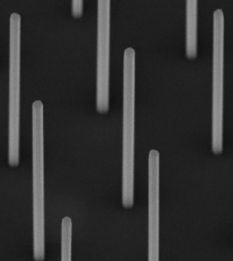Automatic Measuring of Height and Diameter of regular Fibre-Structures
Posted by Fabian on Sep 29, 2010; 6:02am
URL: http://imagej.273.s1.nabble.com/Automatic-Measuring-of-Height-and-Diameter-of-regular-Fibre-Structures-tp3686768.html
Hello everyone.
I am posting this topic, as I have not found the right answer to the following problem, though I think it lies within the scope of ImageJ. Comparable questions have already been posted in this forum, yet they were not exactly what I needed.
As part of my MSc. Thesis, I am analysing Fibre-Structures such as the following by SEM:


I have to determine the height and diameter of each of these fibres. Using the "measure length" tool of ImageJ one by one is awful for large amount of these fibres, so I tried to let ImageJ automatically measure each fibre in parallel and get myself good statistics, not average values.
So far I used the following steps to measure the fibres in the second picture (the one, where each fibre is separated and not overlapping with another):
- Image -> Type -> 8bit
- Image -> Adjust -> Threshold (which separates the dark underground from the light fibres)
- Analyse -> Set Scale
- Analyse -> Set Measurements -> Bounding Rectangle
- Analyse -> Analyse Particles (I set a small minimum size to get rid of any small particles which are obviously not a fibre and also the outlines for control)
This gives me quite good results for the height (height of the bounding rectangle) and for the diameter (width of the bounding rectangle), if the fibres are aligned vertically in the picture and if they are not overlapping.
My problem is the first picture:
How can I make use of the small contrast difference between two fibres and separate them easily so that ImageJ recognises them individually?
I know, that for particles in binary pictures you can use "watershed", or you can use the "Grayscale Morphology" PlugIn to enhance contrast to the underground, but I do not know how to separate two fibres or more.
I hope, that you can help me, as I think this problem is faced in many research areas.
Thank you very much,
Yours,
Fabian
URL: http://imagej.273.s1.nabble.com/Automatic-Measuring-of-Height-and-Diameter-of-regular-Fibre-Structures-tp3686768.html
Hello everyone.
I am posting this topic, as I have not found the right answer to the following problem, though I think it lies within the scope of ImageJ. Comparable questions have already been posted in this forum, yet they were not exactly what I needed.
As part of my MSc. Thesis, I am analysing Fibre-Structures such as the following by SEM:


I have to determine the height and diameter of each of these fibres. Using the "measure length" tool of ImageJ one by one is awful for large amount of these fibres, so I tried to let ImageJ automatically measure each fibre in parallel and get myself good statistics, not average values.
So far I used the following steps to measure the fibres in the second picture (the one, where each fibre is separated and not overlapping with another):
- Image -> Type -> 8bit
- Image -> Adjust -> Threshold (which separates the dark underground from the light fibres)
- Analyse -> Set Scale
- Analyse -> Set Measurements -> Bounding Rectangle
- Analyse -> Analyse Particles (I set a small minimum size to get rid of any small particles which are obviously not a fibre and also the outlines for control)
This gives me quite good results for the height (height of the bounding rectangle) and for the diameter (width of the bounding rectangle), if the fibres are aligned vertically in the picture and if they are not overlapping.
My problem is the first picture:
How can I make use of the small contrast difference between two fibres and separate them easily so that ImageJ recognises them individually?
I know, that for particles in binary pictures you can use "watershed", or you can use the "Grayscale Morphology" PlugIn to enhance contrast to the underground, but I do not know how to separate two fibres or more.
I hope, that you can help me, as I think this problem is faced in many research areas.
Thank you very much,
Yours,
Fabian
| Free forum by Nabble | Disable Popup Ads | Edit this page |